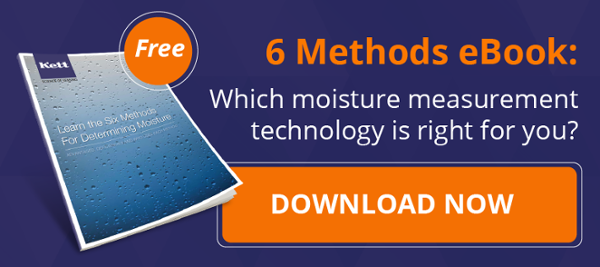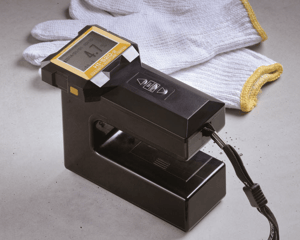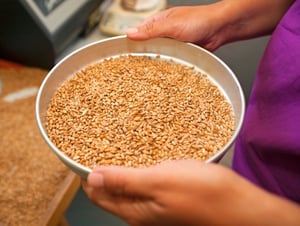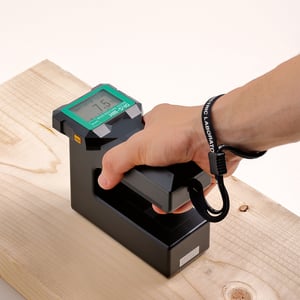 The most effective way to ensure the long-term performance of hygroscopic materials like wood (organic materials that naturally contain water) is to carefully measure and adjust moisture content to achieve an equilibrium moisture content (or EMC) before using the material in production.
The most effective way to ensure the long-term performance of hygroscopic materials like wood (organic materials that naturally contain water) is to carefully measure and adjust moisture content to achieve an equilibrium moisture content (or EMC) before using the material in production.
Hygroscopic materials are constantly exchanging moisture with the surrounding air. When a hygroscopic material like wood is put in an environment containing more moisture than is in the material, moisture is transferred from that environment to the material. This exchange of moisture is continuous and eventually enough is absorbed from the air into the material (or from the material into the air, a process called adsorption) that the material neither gains nor loses moisture. At this point, the object has reached moisture equilibrium with the environment. EMC, or equilibrium moisture content, is the state in which the amount of moisture a material contains has reached equilibrium with its environment – when that object neither gains nor loses moisture from the constant, naturally occurring exchange of moisture with its environment.
This constant exchange of moisture toward EMC makes it difficult for manufacturers using hygroscopic raw materials like wood to accurately measure their moisture level. But accurately measuring moisture is critical because of moisture’s potential to significantly affect the performance of that material in the final product.
When To Measure
It’s critical to get an accurate raw material moisture measurement after the material has been dried and before putting the material in service. The “ideal” moisture content for hygroscopic materials depends on how they are to be used. Hardwood, for example, that’s to be used for cabinetry is usually dried to 6-8% moisture; wood used for construction could have a 15-19% moisture content. No matter the intended use, though, it’s important to correctly dry, handle and store the wood in order to minimize the moisture changes that can occur when the wood is in service. If the wood is at the wrong moisture content when initially put into use, it will adjust to achieve EMC with its environment and therefore may shrink or swell.
Methods for Measuring Moisture
Oven Drying
The oven-drying method of measuring moisture in wood is one of the most universally accepted, but it is slow and requires cutting the wood. This method can also give values greater than true moisture content when used on woods containing volatile extractives. In the oven-drying method, representative portions of wood are weighed; the oven-dried mass and the original mass when cut are used to determine the percentage of moisture content.
Electric
Some of the most effective ways to measure moisture in hygroscopic materials are electrical methods. These are often the preferred methods because they’re quick, the sample used in testing is not destroyed, and these methods can be used on wood already installed in a structure.
Electrical methods of determining moisture content of wood use the relationships between moisture content and measurable electrical properties of wood, such as conductivity (or resistivity), dielectric constant, or power-loss factor. These properties vary in a specific and predictable way as moisture content changes.
Dielectric Meters
Dielectric meters are of two types: those based on dielectric constant are called capacitance; those based on loss factor are called power-loss meters.
The principal advantages of the electrical method compared with oven drying are speed and convenience. Only a few seconds are required for the determination, and the piece of wood being tested is not cut or damaged, except for electrode needle points driven into the wood when using conductance type meters. Dielectric meters are fitted with surface contact electrodes designed for the type of specimen material being tested. The electric field from these electrodes penetrates well into the material.
These features make electrical methods ideal when manufacturers need to quickly sort lumber based on moisture content, when measuring the content of wood installed in a building, or when establishing the moisture content of a large quantity of lumber or other wood items.
The best method for your raw materials and end product will depend on how the wood or other product will be used. Wood in service will always be undergoing slight changes depending on the humidity level of the environment it’s in; most of these are very small and have little or no impact on the product’s performance. These changes can be greatly minimized when the moisture content is measured correctly and adjustments are made to ensure that EMC has been reached.
Though relative humidity's impact on the performance of wood is a great example of how and why to measure moisture, there are nearly as many factor variables as there are products. Unfortunately, there isn't a one-size-fits-all means to get the best result. Learn the best options for your situation in our6 Methods of Moisture Measurement ebook.



